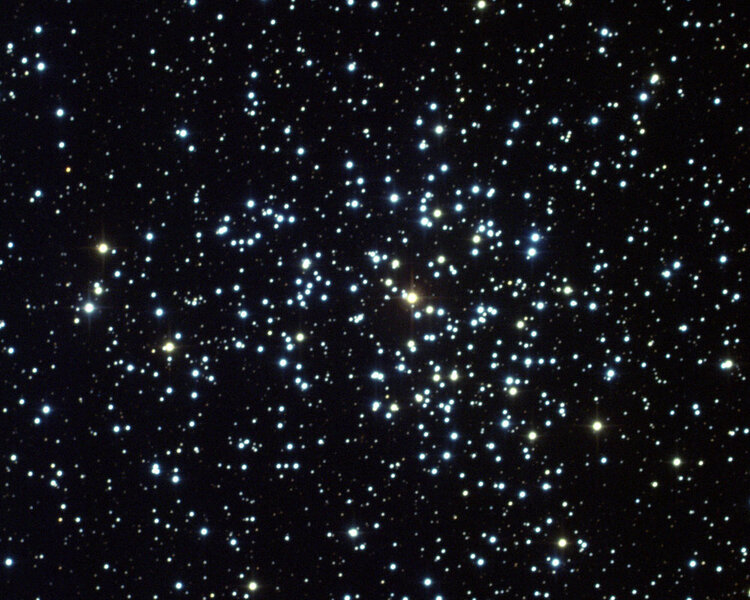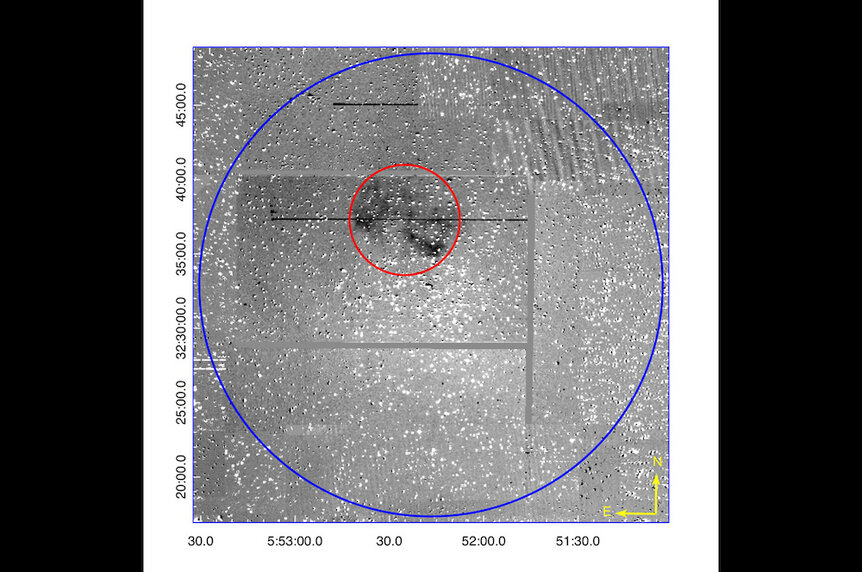Create a free profile to get unlimited access to exclusive videos, sweepstakes, and more!
Astronomers find the death cry of a star in a cluster long ago and not so very far away
The oldest planetary nebula ever seen is in the star cluster M37.

A team of astronomers has found what may be the oldest known planetary nebula ever seen, and certainly one of the biggest. These structures are fleeting on a cosmic timescale, so finding one so old is extremely helpful in nailing down what happens as stars die.
Bonus: It was confirmed to be in a bright, nearby stellar cluster, making it far easier to nail down several of its characteristics [link to paper].
A planetary nebula is a huge cloud of gas blown off by a star like the Sun as it ages and dies. Stars generate energy by fusing lighter elements into heavier ones in their cores. They can do this for billions of years, but eventually the usable fuel runs out. This sets off a complicated chain of events, but in a nutshell the core contracts and heats up, while the outer layers of the star expand and cool. The star becomes a red giant, and blows a wind of gas away that eventually depletes it of gas.
The core of the star, dense and hot and exposed to space, is now called a white dwarf. It’s so hot it pours out ultraviolet light that excites the gas it previously blew away, which responds by glowing quite literally like a neon sign. That’s the planetary nebula. Over time the expanding gas gets so spread out the ultraviolet light passes right through it, so the nebula fades away. This typically takes a few thousand years, which is the blink of an eye in a star’s lifetime.
A few thousand planetary nebulae are known in our galaxy, but most are distant, small, and faint.
RELATED: Crash Course Astronomy: White Dwarfs and Planetary Nebulae
The planetary nebula in question here is called IPHASX J055226.2+323724 — let’s call it J0552 for short. It was discovered in 2008, right on top of the well-known open cluster M 37. Open clusters are small collections of hundreds or thousands of stars, typically all born at the same time from a single cloud of gas. Thousands are known, and some are close enough to see by the naked eye, like the Pleiades or the Hyades, the latter of which is the V-shaped series of stars that makes up the head of the constellation Taurus the Bull.
I was delighted to read about this planetary nebula because M 37 is one of a few bright open clusters in the constellation of Auriga that are easily seen from a dark site with binoculars. I’ve observed it many, many times with my own telescope because it’s big, bright, and very easy to find.
The nebula J0552 is large on the sky for a planetary nebula, about a tenth of a degree, or a fifth the size of the full Moon on the sky. It’s incredibly faint, and only shows up in very deep exposures using filters that block all light except for the reddish hue that comes from glowing hydrogen gas. It appears to be just off-center in M37, well inside the cluster.
The problem here is that space is deep, and things can appear to overlap while being at wildly different distances. Just seeing a nebula coincident in the sky with an open cluster doesn’t mean they’re physically associated.
The new work shows that the two are in fact related. One key is finding the planetary nebula central star, the star that cast off the gas in the first place. That’s usually easy for small nebulae, but for big ones, especially in dense fields of stars, it can be difficult. However in this case it wasn’t too hard: Young white dwarfs tend to be blue and hot, and there’s only one blue star anywhere near the nebula center. Observations indicate it is in fact a white dwarf with a temperature of 100,000° C, and it’s moving through space along with the cluster. These pretty much clinch its membership.
The beauty of this is that we know the cluster’s distance from us: about 4,700 light-years away. That gives the physical size of the nebula as 10 light-years, which is huge. Most fade away when they’re a fraction of that size.
Using spectra, the astronomers determined the nebular gas is expanding at a rate of about 20 kilometers per second. Knowing its distance and size, that gives an age of the nebula of about 80,000 years, making this the oldest planetary nebula ever seen.
An important relationship in how stars die is how massive the star was at first, and how massive the white dwarf it leaves behind is when the star dies. The central white dwarf star of J0552 has a mass of about 0.6 times that of the Sun now. Using the characteristics of the cluster the astronomers find it started off life with 2.8 times the Sun’s mass, making it a beefy blue-white star back in the day.
With these numbers in hand, plus the age, size, and chemical composition of the gas determined from spectra, astronomers can learn quite a bit about what happens when stars die. On top of that, only two other planetary nebulae are known in our galaxy that exist in open clusters, so this helps us understand these stellar jewels as well. Interestingly, the other two are large, old, and come from higher mass stars as well. That might be due to a bias: Open clusters disperse over time, so we tend to see them when they’re relatively young. It takes time for a star to die, with higher-mass stars dying first, so of course in a young cluster we’ll likely only see planetary nebulae from more massive stars.
Or it might be telling us something fundamental about the way clusters make stars and how those stars die. That will take a lot more observations, but that first step is finding these cluster nebulae. J0552 is a precious object.
Mind you, our own Sun will follow this path someday. Not for many billions of years, but it too will run out of core fuel, swell up (engulfing the Earth in the process), blow off its outer layers, and form a planetary nebula. Studying these objects means studying ourselves, if our far-distant-future selves. But if we want a complete picture of the Sun and Earth, we need to understand the whole picture, including what happens, and how, eons from now.





























